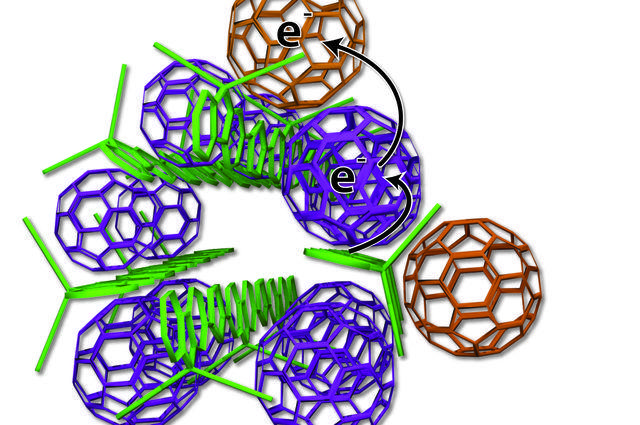The concept of imitating natural systems in the built environment is known as “Biomimicry,” and it holds great promise for advancements in many areas of technology, including solar. Several new, cutting edge research project are looking at biomimetic solutions to solar’s nagging problems.
Plastic Solar Panels Imitate Photosynthesis
A UCLA press release this week announced chemists there have developed a new solar cell design that is inspired by the way that plants generate energy through photosynthesis. The team’s full report, entitled Long-lived photoinduced polaron formation in conjugated polyelectrolyte-fullerene assemblies is available at the website of the journal Science.
“Biology does a very good job of creating energy from sunlight,” said Sarah Tolbert, a UCLA professor of chemistry and one of the senior authors of the research. “Plants do this through photosynthesis with extremely high efficiency.”
In the search to find a lower-cost alternative to the silicon solar cell, scientists are looking at several different plastics, but to date, the new non-silicon cells lack the efficiency needed to compete. According to the report, “the two components that make the UCLA-developed system work are a polymer donor and a nano-scale fullerene acceptor. The polymer donor absorbs sunlight and passes electrons to the fullerene acceptor; the process generates electrical energy.
The plastic materials, called organic photovoltaics, are typically organized like a plate of cooked pasta — a disorganized mass of long, skinny polymer ‘spaghetti’ with random fullerene ‘meatballs.’ But this arrangement makes it difficult to get current out of the cell because the electrons sometimes hop back to the polymer spaghetti and are lost. The UCLA technology arranges the elements more neatly — like small bundles of uncooked spaghetti with precisely placed meatballs. Some fullerene meatballs are designed to sit inside the spaghetti bundles, but others are forced to stay on the outside. The fullerenes inside the structure take electrons from the polymers and toss them to the outside fullerene, which can effectively keep the electrons away from the polymer for weeks.”
Although the technology is far from ready-for-primetime, it shows some very exciting promise. Yves Rubin, a UCLA professor of chemistry and another senior co-author of the study says, “We don’t have these materials in a real device yet; this is all in solution…When we can put them together and make a closed circuit, then we will really be somewhere.”
Moth Eyes Inspire New Solar Coating
Meanwhile, across the country at Oak Ridge National Laboratory, scientists have developed a new water-repelling, anti-reflective glass coating that could increase the efficiency of solar panels by up to six per cent. Mimicking the characteristics of moth eyes and lotus leaves, the new coating is produced using inexpensive industry-standard techniques, resists high temperatures and is also super tough.
“While lotus leaves repel water and self-clean when it rains, a moth’s eyes are antireflective because of naturally covered tapered nanostructures where the refractive index gradually increases as light travels to the moth’s cornea,” said Tolga Aytug, member of ORNL’s Materials Chemistry Group.
The full report, Monolithic graded-refractive-index glass-based antireflective coatings: broadband/omnidirectional light harvesting and self-cleaning characteristics can be read online.
 Popularized in a 2002 book entitled Biomimicry: Innovation Inspired by Nature by science writer Janine Benyus, the motivations behind biomimicry are as old as humanity. In her Biomimicry Primer (available as a free pdf download), Benyus writes:
Popularized in a 2002 book entitled Biomimicry: Innovation Inspired by Nature by science writer Janine Benyus, the motivations behind biomimicry are as old as humanity. In her Biomimicry Primer (available as a free pdf download), Benyus writes:
“Yearning for something that works for instead of against life, professional innovators are heading outside to see how other species have managed to survive for 3.85 billion years. Their models are organisms that manufacture without “heat, beat, and treat,” and ecosystems that run on sunlight and feedback, creating opportunities rather than waste. The resulting designs are functional, sustainable, and not surprisingly, beautiful as well. Beauty is a large part of why biomimicry resonates. Our search for mentors brings us back into contact with the living world, a place we were tuned to appreciate. Having spent 99.9% of our planetary tenure woven deep into the wild, we humans naturally admire the weaverbird’s nest, the conch’s shell, the scales of a shimmering trout. In fact, there are few things more beautiful to the human soul than good design.”






